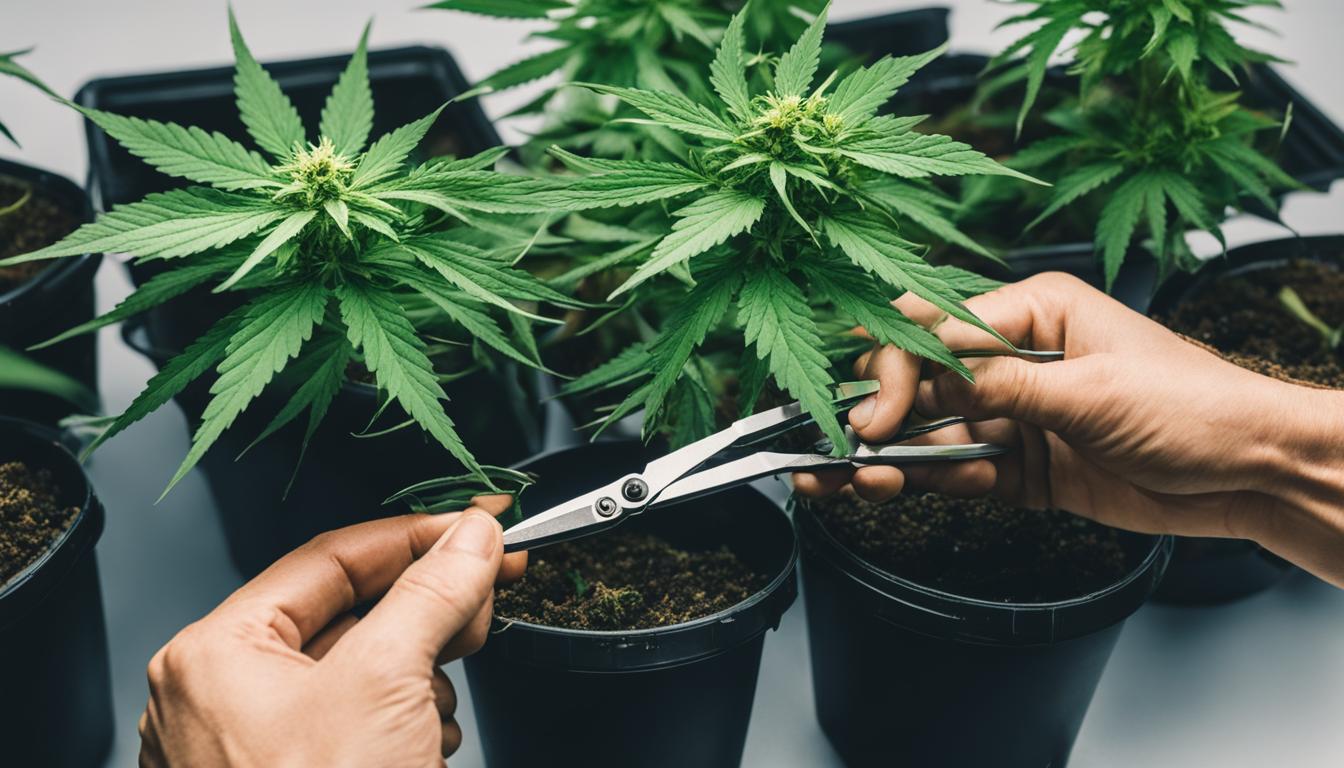Uncategorized
Easy Guide to Cloning Cannabis at Home
Cloning, or propagating, cannabis plants is a popular method among experienced growers. It allows them to preserve the genetics of a specific plant and produce consistent results. In this easy guide, I will walk you through the process of cloning cannabis at home, providing step-by-step instructions and tips for success.
Cloning cannabis is an effective way to replicate the characteristics of your favorite plants and ensure a high success rate. Whether you’re looking to propagate specific strains or preserve the traits of a particular plant, cloning offers a reliable and efficient solution.
Before we dive into the step-by-step process, let’s explore why cloning cannabis can be beneficial and how to select the right mother plant for optimal results.
Key Takeaways:
- Cloning cannabis allows you to preserve genetic traits and reproduce specific plant characteristics.
- Benefits of cannabis cloning include higher success rates compared to seed germination and time-saving advantages.
- Choosing a healthy and high-performing mother plant is crucial for successful cloning.
- Select plants with desirable traits, such as strong growth, resin production, aroma, and flavor.
- Maintain a clean and pest-resistant environment for your clones to thrive.
Why Clone Cannabis?
Cloning cannabis offers several benefits and advantages that make it a popular choice among growers.
Preserve Desired Genetics
One of the key benefits of cannabis cloning is the ability to preserve the genetics of a specific plant. By cloning a plant, you can ensure that its desirable traits, such as potency, aroma, or yield, are passed on to the new plants. This allows you to consistently reproduce the same high-quality cannabis, maintaining the integrity of your favorite strains.
Higher Success Rate
Compared to growing cannabis from seeds, cloning offers a higher success rate. When you clone a cannabis plant, the cutting you take already has well-established roots, meaning it is already rooted and ready to grow. This eliminates the uncertainty and variability that comes with germinating seeds. With cloning, you have a greater assurance that the new plants will thrive and exhibit the desired characteristics.
Time and Effort Saving
Cloning cannabis can save you time and effort in the cultivation process. When you germinate seeds, you need to ensure the optimal conditions for successful germination, such as temperature, moisture, and light exposure. With cloning, you skip this step altogether and can directly focus on nurturing the new clones, accelerating the growth process. This can be especially beneficial for those looking for a quicker turnaround or who want to maximize their harvest within a specific timeframe.
Overall, cannabis cloning provides growers with a reliable method of reproducing desired genetics, increasing the chances of successful growth, and saving time and effort in the cultivation process. The next section will explore how to choose the right mother plant for cloning, an essential step in the cloning process.
| Benefits of Cannabis Cloning |
|---|
| Preserves desired genetics |
| Higher success rate compared to seeds |
| Saves time and effort |
Choosing the Right Mother Plant for Cloning
When it comes to cannabis cloning, selecting the right mother plant is crucial for producing healthy and high-quality clones. The mother plant serves as the genetic source for your clones, so it’s essential to choose a plant with desirable traits that you want to replicate.
Desirable Traits to Look For
When selecting a mother plant for cloning, consider the following desirable traits:
- Strong growth: Choose a plant that exhibits vigorous growth and has strong branches. This will ensure that your clones will have a solid foundation for optimal growth.
- High resin production: Look for plants that are known for producing ample amounts of resin. This trait is especially important if you are looking to create cannabis products with high THC or CBD content.
- Desired aromas or flavors: If you have specific aromatic or flavor profiles you enjoy, select a mother plant that showcases those characteristics. This will ensure that your clones inherit those desirable qualities.
- Pest and disease resistance: Choose a plant that has shown resistance to common cannabis pests and diseases. This will help prevent the spread of infections or infestations to your clones.
By carefully selecting a mother plant with these traits, you can increase the likelihood of producing high-quality clones that meet your specific preferences and requirements.
The Importance of Health
In addition to desirable traits, it’s crucial to choose a healthy mother plant for cloning. A healthy plant will have vibrant leaves, strong stems, and an overall robust appearance. Avoid selecting plants that exhibit signs of nutrient deficiencies, pest damage, or diseases.
When selecting a mother plant, always remember that healthy plants will produce healthy clones. Take the time to inspect the plant closely and ensure that it is in optimal condition.
Choosing a healthy mother plant will reduce the risk of propagating any underlying health issues or weaknesses to your clones. It will also increase the chances of successful rooting and subsequent growth.
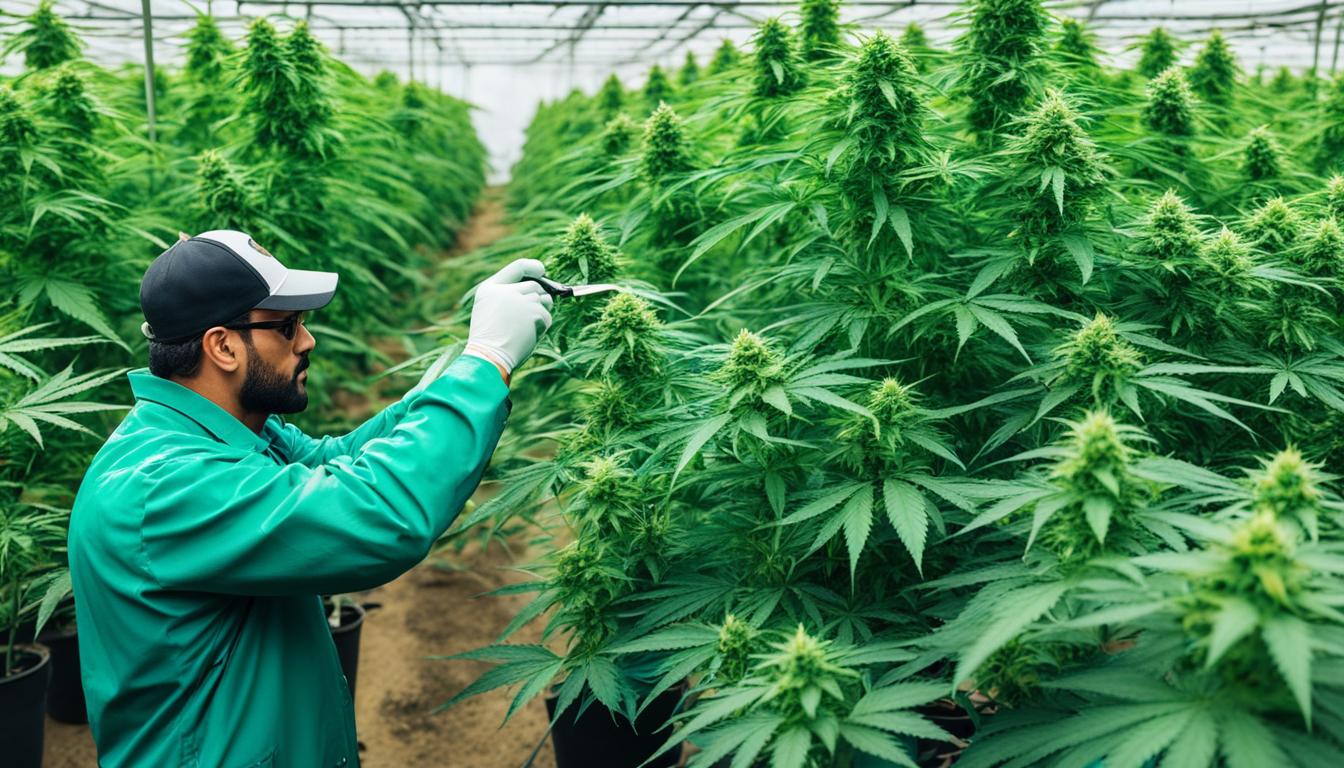
Materials Needed for Cloning Cannabis
To successfully clone cannabis plants at home, you will need the following materials:
1. Healthy Mother Plant: Start with a strong and healthy mother plant that exhibits the desired traits you want to propagate.
2. Clean and Sharp Scissors or Razor Blade: These tools are essential for making clean and precise cuts on the plants.
3. Rooting Hormone (Gel or Powder): Rooting hormone helps stimulate root growth and increases the success rate of cloning.
4. Cloning Cubes: Choose cloning cubes made from materials like rockwool or jiffy pellets. These cubes provide a suitable environment for root development.
5. Propagator or Dome: A propagator or dome creates a controlled environment that promotes humidity and helps the clones retain moisture.
6. Light Source: Use a fluorescent or LED light to provide the necessary light spectrum for the clones’ growth and development.
7. Clean Glass of Water: A clean glass of water is useful for hydrating the clones and temporarily storing them during the cloning process.
These materials are essential for successful cannabis cloning. Having them on hand will ensure that you are well-prepared to embark on your cloning journey.
Table 4: Materials Needed for Cloning Cannabis
| Materials | Description |
|---|---|
| Healthy Mother Plant | A strong and healthy plant with desired traits |
| Clean and Sharp Scissors or Razor Blade | To make clean and precise cuts |
| Rooting Hormone (Gel or Powder) | Stimulates root growth and increases success rate |
| Cloning Cubes | Rockwool or jiffy pellets for root development |
| Propagator or Dome | Creates a controlled environment for humidity and moisture retention |
| Light Source | Fluorescent or LED light for optimal growth |
| Clean Glass of Water | For hydration and temporary storage |
Step-by-Step Guide to Cloning Cannabis
Cloning cannabis is a straightforward process that can be done in a few simple steps. Follow this step-by-step guide to successfully clone your cannabis plants:
- Select a healthy branch from the mother plant and make a clean cut just below a leaf node. This will ensure that the cutting receives enough nutrients to develop roots.
- Remove any lower leaves from the cutting, leaving only a few leaves at the top. This will reduce moisture loss and allow the cutting to focus on root development.
- Dip the cut end of the cutting into rooting hormone. This will stimulate root growth and increase the chances of successful cloning.
- Plant the cutting into a cloning cube, such as rockwool or jiffy pellets. Make sure the cutting is firmly placed in the cube to provide stability.
- Place the clones in a propagator or dome with a light source. This will create a warm and humid environment that promotes root development.
- Maintain a temperature of 18-22°C and humidity above 90%. These conditions are optimal for root growth and overall clone health.
- Mist the clones with water daily to keep them hydrated. This will prevent the cuttings from drying out and promote root development.
- After a few weeks, the clones should develop roots. At this stage, they can be transplanted into pots or containers for further growth.
Following these steps will give you the best chances of successfully cloning your cannabis plants. Remember to provide proper care and attention to your clones to ensure their healthy growth.
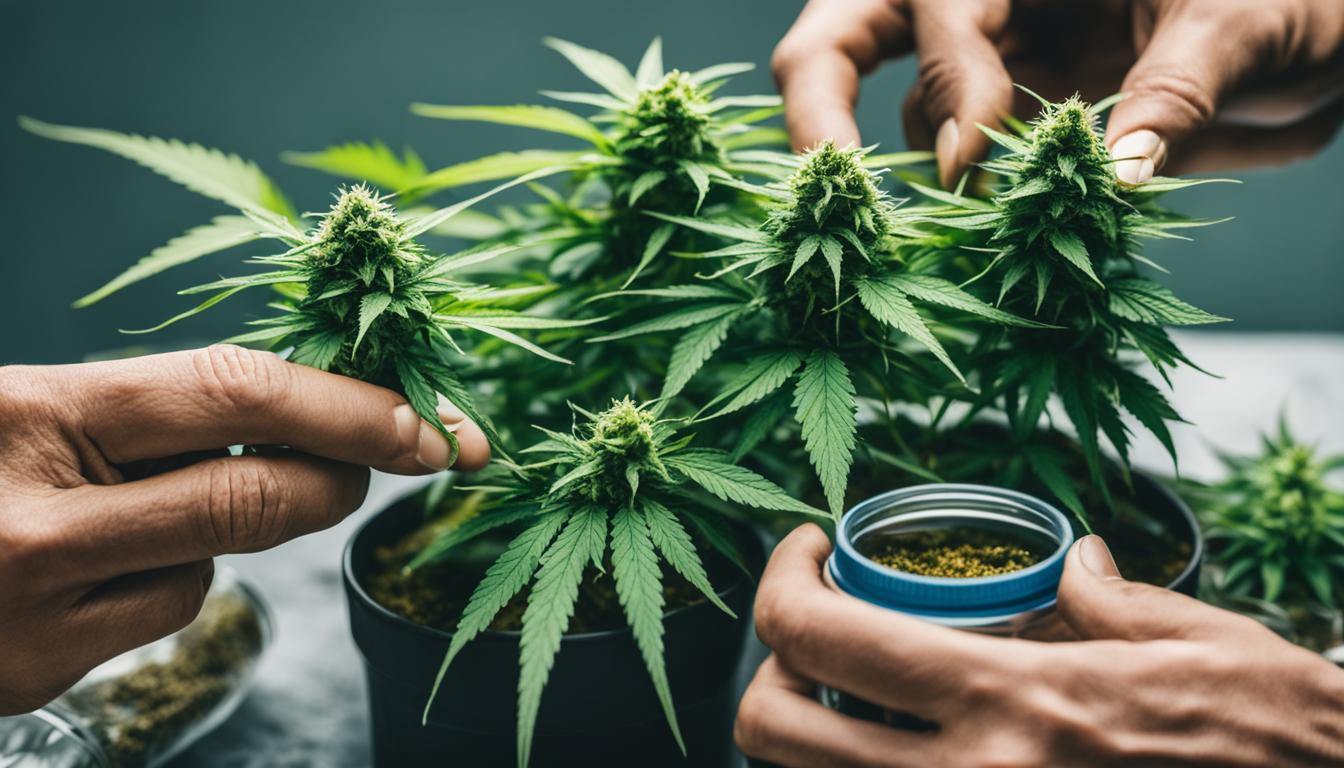
| Step | Description |
|---|---|
| 1 | Select a healthy branch from the mother plant and make a clean cut just below a leaf node. |
| 2 | Remove any lower leaves from the cutting, leaving only a few leaves at the top. |
| 3 | Dip the cut end of the cutting into rooting hormone. |
| 4 | Plant the cutting into a cloning cube, ensuring it is firmly placed. |
| 5 | Place the clones in a propagator or dome with a light source. |
| 6 | Maintain a temperature of 18-22°C and humidity above 90%. |
| 7 | Mist the clones with water daily to keep them hydrated. |
| 8 | After a few weeks, the clones should develop roots and can be transplanted into pots. |
Cloning Techniques for Cannabis
When it comes to cloning cannabis, there are several techniques you can employ to ensure successful propagation. Each method has its own advantages, and the choice ultimately depends on your preferences and resources. Here are some of the most popular cannabis cloning techniques:
1. Cloning Cubes
Cloning cubes, such as rockwool or jiffy pellets, are widely used in cannabis cloning due to their ability to provide a sterile and well-drained environment for root development. These cubes are made from inert materials that don’t retain excessive moisture, preventing the risk of overwatering and root rot. They also have excellent air circulation, allowing for better oxygenation and faster root growth.
Here’s a step-by-step guide to cloning cannabis using cloning cubes:
- Prepare your cloning cubes by soaking them in pH-balanced water.
- Make a small hole in the center of each cube using a pen or pencil.
- Take a cutting from the mother plant, ensuring it has at least two sets of leaves.
- Dip the cutting’s stem in rooting hormone to stimulate root development.
- Insert the cutting into the prepared hole in the cloning cube, making sure it is snug and secure.
- Place the cubes in a propagator or a high-humidity environment to maintain moisture levels.
- Provide adequate lighting to promote photosynthesis and growth.
- Monitor the clones’ progress and adjust environmental conditions as needed.
Using cloning cubes is a reliable and efficient method, especially for beginners or those seeking a foolproof way to clone cannabis.
2. Water Cloning
Another popular technique for cloning cannabis is water cloning. This method involves placing the cuttings in a glass of clean water until roots develop. Water cloning has the advantage of being straightforward and cost-effective, requiring minimal supplies. It allows you to observe root growth directly and eliminates the need for transplanting.
Here’s a simplified process for water cloning:
- Take cuttings from the mother plant, ensuring they have a few sets of leaves.
- Trim the bottom of each cutting at a 45-degree angle to encourage root growth.
- Place the cuttings in a glass of clean water, ensuring the nodes are submerged.
- Change the water every few days to maintain cleanliness and oxygen levels.
- Keep the glass in a warm, well-lit area but away from direct sunlight.
- Monitor the cuttings for root development, which typically takes a few weeks.
- Once roots have formed, transfer the clones to a growing medium or soil.
Water cloning offers simplicity and visual confirmation of root growth, making it a popular choice among growers.
3. Soil Cloning
Cloning cannabis in soil is a straightforward and natural method that many growers prefer. It involves planting the cuttings directly into a well-draining potting mix or soil. Soil cloning allows for easy transition and encourages strong root development.
Here are the basic steps for cloning cannabis in soil:
- Select a healthy cutting from the mother plant, ensuring it has enough foliage.
- Trim the cutting’s stem to remove excess leaves, leaving a few at the top for photosynthesis.
- Dip the cutting in rooting hormone to stimulate root growth.
- Prepare a small pot with moistened, well-draining soil or potting mix.
- Make a small hole in the soil using your finger or a pencil.
- Place the cutting into the hole, ensuring it is inserted deep enough to support stability.
- Gently firm the soil around the cutting to remove any air gaps.
- Water the pot to maintain moisture, but avoid overwatering.
- Place the pot in a warm and well-lit area, providing indirect sunlight.
Soil cloning offers a familiar and reliable method for propagating cannabis, as it closely mimics the natural growth environment.
| Cloning Technique | Advantages |
|---|---|
| Cloning Cubes |
|
| Water Cloning |
|
| Soil Cloning |
|
Remember, regardless of the method you choose, maintaining proper environmental conditions, such as temperature, humidity, and lighting, is crucial for successful cannabis cloning. Monitor your clones closely and provide them with the care and attention they need to thrive.
Care and Maintenance of Clones
Once you have successfully cloned your cannabis plants, it’s crucial to provide them with the proper care and maintenance for their continued growth. By following these essential guidelines, you can ensure the health and vitality of your cloned cannabis plants.
Light, Water, and Nutrients
Caring for cannabis clones involves giving them adequate light, water, and nutrients to support their growth:
- Light: Maintain a light cycle of 18 hours of light and 6 hours of darkness to promote vegetative growth. Position the clones under a fluorescent or LED light source to provide the necessary lighting intensity for healthy development.
- Water: Keep the clones hydrated by misting them with water regularly. Avoid overwatering, as it can lead to root rot and other issues. Monitor the moisture levels in the cloning cubes or growing medium and adjust watering accordingly.
- Nutrients: Provide the clones with a balanced nutrient solution specifically formulated for young plants. Start with a diluted concentration and gradually increase the strength as the clones grow. Ensure that the nutrient solution is pH-balanced for optimal absorption.
Temperature and Humidity
The temperature and humidity levels play a crucial role in the successful growth of cannabis clones:
- Temperature: Maintain a temperature range of 18-26°C (65-80°F) during the vegetative stage. Avoid significant temperature fluctuations, as they can stress the clones. Use a thermometer to monitor the temperature and adjust as needed.
- Humidity: Clones require high humidity levels for root development. Aim for a humidity level above 70% to create optimal conditions. Use a hygrometer to monitor the humidity and place a humidity dome over the clones if needed.
Transplanting
Once the clones have developed a healthy root system, it’s time to transplant them into larger pots:
- Gently remove the clones from the cloning cubes, taking care not to damage the delicate roots.
- Prepare a pot with a well-draining growing medium, such as a mix of coco coir and perlite.
- Make a hole in the center of the pot and place the clone, ensuring that the roots are covered with the growing medium.
- Water the transplanted clone with a light nutrient solution to help it establish in its new pot.
- Place the transplanted clones back under the grow lights and continue to provide them with the necessary care and maintenance.
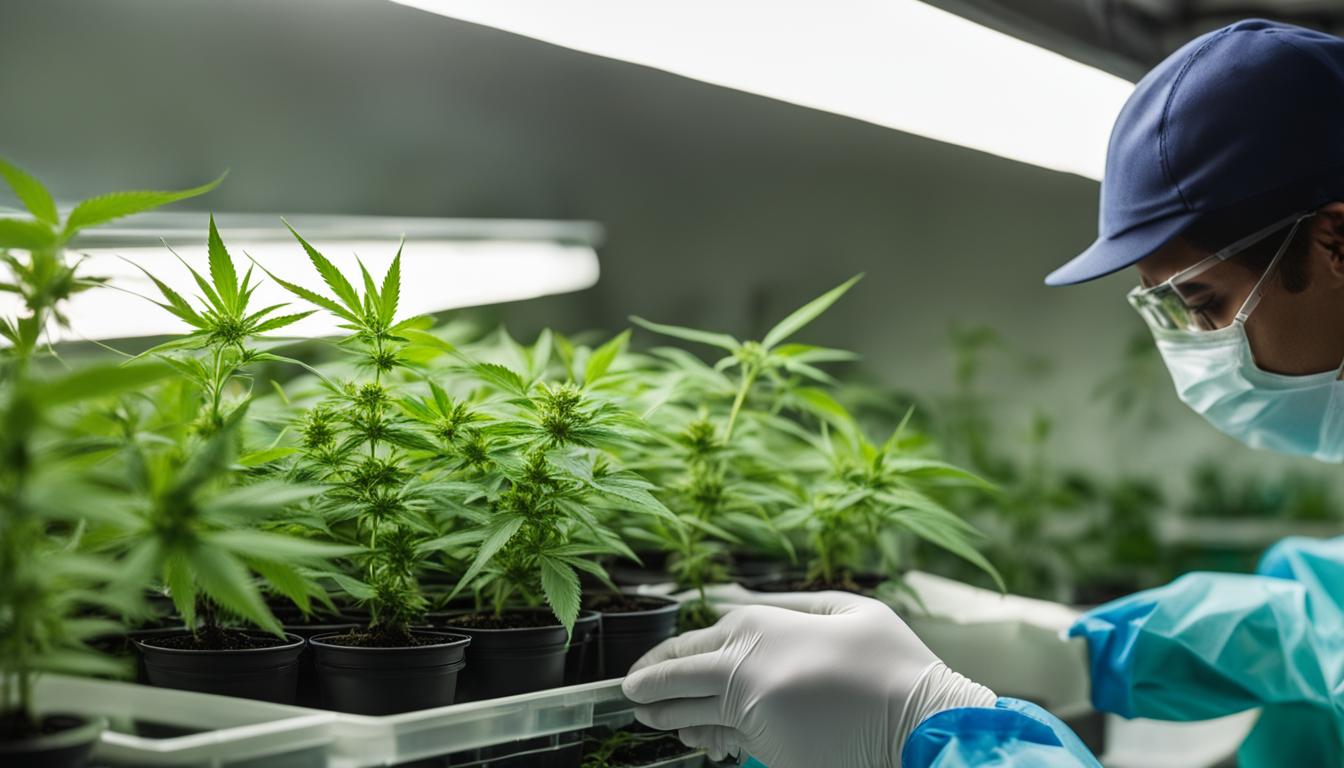
Remember that each clone is a unique individual, and careful attention to their needs will help them thrive. Monitor their growth, look out for any signs of nutrient deficiencies or pests, and make any necessary adjustments to their care regimen.
Troubleshooting Common Issues in Cloning
Cloning cannabis can sometimes be a challenging process, and various issues can arise along the way. Understanding and troubleshooting these common problems will help you improve your success rate and produce healthy cannabis clones.
Common Problems in Cannabis Cloning
- Over-watering or under-watering: Improper watering can lead to root rot or dehydration in cannabis clones. It’s essential to find the right balance and monitor soil moisture or cube saturation carefully.
- Insufficient light: Clones need adequate light for photosynthesis and proper root development. Inadequate light can result in weak and stretchy clones that are prone to disease.
- Improper temperature and humidity levels: Incorrect temperature and humidity conditions can hinder root development in clones. It’s crucial to maintain optimal levels to ensure healthy growth.
- Pests and diseases: Clones are vulnerable to pests and diseases, particularly if the cloning environment is not clean and sterile. Regular inspections and preventive treatments are necessary to protect your clones.
To troubleshoot these issues, consider the following:
- Monitor watering: Ensure you are providing the right amount of water to your clones, keeping the soil or cloning cubes moist but not overly saturated.
- Adjust lighting: If your clones are stretching or showing signs of weak growth, increase the amount and intensity of light they receive. Consider using specialized grow lights if necessary.
- Optimize temperature and humidity: Use a thermometer and hygrometer to monitor temperature and humidity levels in your cloning area. Make adjustments as needed to create an environment suitable for root development.
- Maintain cleanliness: Regularly clean and sterilize your cloning tools, trays, and growing area to prevent the spread of pests and diseases. Practice good hygiene when handling clones to avoid contamination.
Remember, troubleshooting common issues in cloning requires proactive monitoring and adjustment. By understanding the needs of your clones and providing the right conditions, you can overcome these challenges and ensure successful cannabis cloning.
Check out the table below for a summary of common issues in cannabis cloning and their troubleshooting solutions:
| Common Issues | Troubleshooting Solutions |
|---|---|
| Over-watering or under-watering | Monitor moisture levels and adjust watering accordingly |
| Insufficient light | Increase light intensity or duration |
| Improper temperature and humidity levels | Monitor and adjust temperature and humidity in the cloning area |
| Pests and diseases | Maintain cleanliness and regularly inspect clones for signs of pests or diseases |
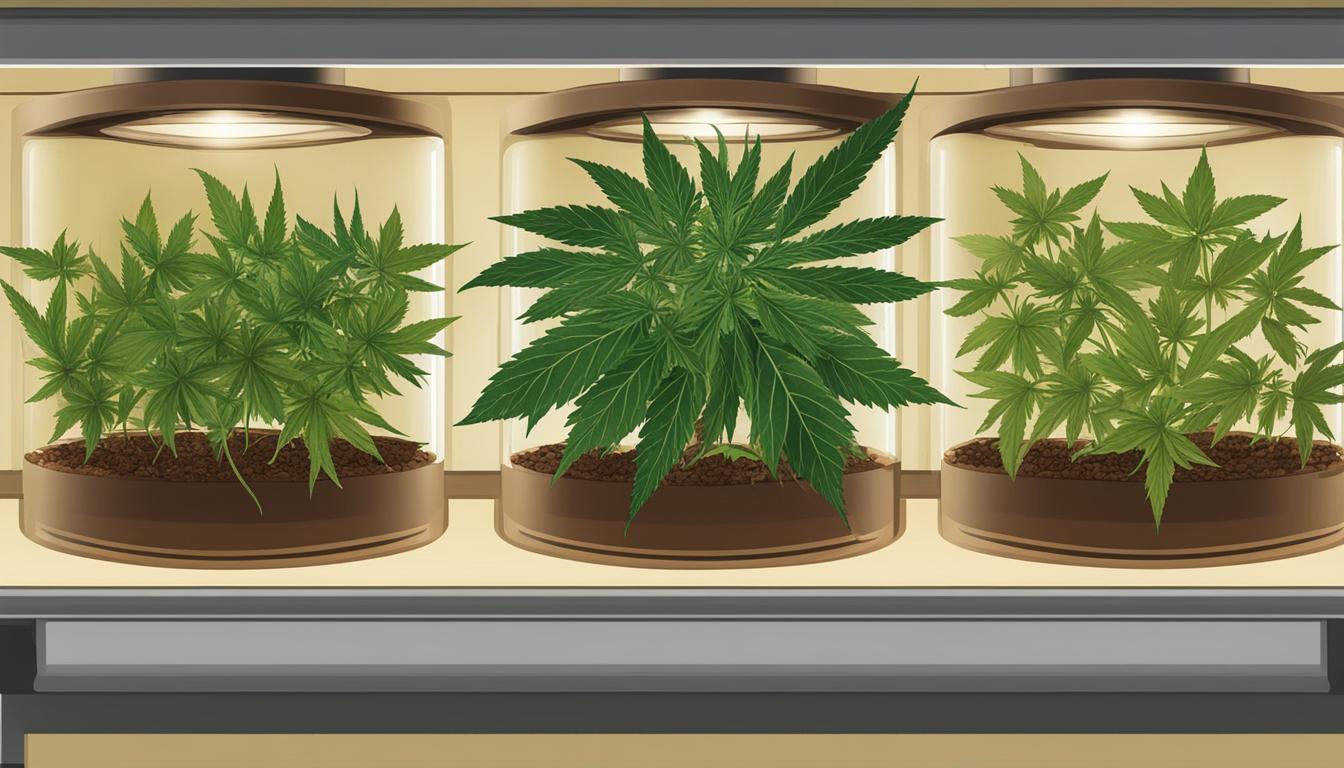
Additional Tips for Successful Cannabis Cloning
When it comes to cannabis cloning, implementing the right techniques and practices can significantly improve your success rate. Here are some additional tips to help you achieve successful cannabis cloning:
- Take multiple cuttings: Increasing the number of cuttings you take from the mother plant can improve your chances of successful cloning. Not every cutting will root successfully, so by taking multiple cuttings, you increase the likelihood of obtaining viable clones.
- Choose the right time to take cuttings: Timing is crucial when it comes to taking cuttings for cannabis cloning. The best time to take cuttings is during the vegetative stage when the plant is actively growing and has plenty of energy to support root development.
- Keep tools and workspace clean: Maintaining a clean and sanitized environment is essential to prevent the introduction of diseases or infections. Clean your tools, such as scissors or razor blades, before and after each use. Also, make sure your workspace is free from debris to minimize the risk of contamination.
- Use a rooting hormone: Applying a rooting hormone to the cut end of the cloning is a proven method to stimulate root growth. Choose a high-quality rooting hormone, either in gel or powder form, and follow the manufacturer’s instructions for application.
- Monitor and adjust temperature and humidity: Creating optimal conditions for rooting is crucial for successful cannabis cloning. Maintain a temperature between 20-25°C (68-77°F) and a humidity level above 90% to promote root development. Use a hygrometer to monitor these factors and make adjustments if necessary.
By following these additional tips, you can increase your chances of successful cannabis cloning and achieve consistent results with your favorite strains.
Conclusion
In conclusion, cannabis cloning is a valuable technique for growers looking to reproduce their favorite plants with consistent results. By following the step-by-step guide outlined in this article and providing proper care and attention to your clones, you can achieve successful results.
It is important to experiment with different cloning techniques and adjust your approach based on the specific needs of your plants. With practice and experience, you can become proficient in the art of cannabis cloning and improve your success rate.
Remember to select a healthy and high-performing mother plant, use clean and sharp tools, and provide optimal conditions for rooting. Taking multiple cuttings and choosing the right time in the plant’s growth cycle for cloning can also increase your chances of success.
By mastering cannabis cloning, you can preserve the genetics of your favorite plants and ensure consistent quality in your harvest. Whether you’re a seasoned grower or just starting out, cannabis cloning is a rewarding and efficient method for propagating cannabis plants.
“Cloning is a fantastic way to produce large quantities of genetically identical offspring that are reliable and consistent.” – Dr. Tammy Relieves, Cannabis Researcher
Remember to always check your local laws and regulations regarding cannabis cultivation and propagation.
| Benefits of Cannabis Cloning | Advantages of Cloning Cannabis |
|---|---|
| Preserve genetics of specific plants | Higher success rate compared to growing from seeds |
| Consistent results | Save time and effort of germinating seeds |
| Reproduce desired traits |
With the knowledge and skills gained from this cannabis cloning guide, you are well-equipped to embark on your own cloning journey. Enjoy the process and the rewards of growing your own cannabis!
References:
- Alchimiaweb, S.L.: [Include the URL of the first source here]
- [Include the URL of the second source here]
- [Include the URL of the third source here]
References
For more information and resources on cannabis cloning, consider the following sources:
1. Alchimiaweb, S.L.: https://www.alchimiaweb.com/
2. [Include the URL of the second source here]
3. [Include the URL of the third source here]
Cloning cannabis offers several advantages, including preserving the genetics of a specific plant, ensuring consistent results, and a higher success rate compared to growing from seeds. Cloning also saves time and effort by eliminating the need to germinate seeds. When selecting a mother plant for cloning, choose a healthy and high-performing plant with desirable traits, such as strong growth, high resin production, desired aromas or flavors, and pest and disease resistance. Selecting the right mother plant will ensure that your clones inherit these desirable traits. To clone cannabis, you will need a healthy mother plant, clean and sharp scissors or a razor blade, rooting hormone (gel or powder), cloning cubes (such as rockwool or jiffy pellets), a propagator or a dome, a light source (fluorescent or LED), and a clean glass of water. The step-by-step process for cloning cannabis includes selecting a healthy branch from the mother plant, making a clean cut just below a leaf node, removing lower leaves, dipping the cutting into rooting hormone, planting it into a cloning cube, placing the clones in a propagator or dome with a light source, maintaining optimal temperature and humidity, misting the clones daily, and transplanting them into larger pots once roots develop. The most common techniques for cloning cannabis include using cloning cubes (such as rockwool or jiffy pellets), water, or soil. Cloning cubes provide a sterile and well-drained environment for root development, while water cloning involves placing the cuttings in a glass of clean water until roots develop. Cloning in soil involves planting the cuttings directly into a pot with well-draining soil. To care for cannabis clones, provide them with adequate light, water, and nutrients. Maintain a light cycle of 18 hours of light and 6 hours of darkness to promote vegetative growth. Keep the clones hydrated by misting them with water regularly. Monitor temperature and humidity levels for optimal growing conditions. Transplant the clones into larger pots once they have developed roots. Common issues in cloning cannabis include over-watering or under-watering, insufficient light, improper temperature and humidity levels, and pests and diseases. To troubleshoot these issues, monitor and adjust watering practices, provide adequate light and optimal environmental conditions, and maintain a clean and sterile environment to prevent pests and diseases. Some additional tips for successful cannabis cloning include taking multiple cuttings to increase success chances, choosing the right time in the plant’s growth cycle for taking cuttings, keeping tools and workspace clean and sanitized, using a rooting hormone to promote root development, and monitoring and adjusting temperature and humidity levels to create optimal rooting conditions. Some reliable sources for cannabis cloning information include Alchimiaweb, S.L. (insert URL) and [source 2] (insert URL).FAQ
What are the benefits of cloning cannabis?
How do I choose the right mother plant for cloning?
What materials do I need for cloning cannabis?
What is the step-by-step process for cloning cannabis?
What are the different techniques for cloning cannabis?
How do I care for and maintain cannabis clones?
What are common issues in cloning cannabis and how can I troubleshoot them?
What are some additional tips for successful cannabis cloning?
What are the sources for cannabis cloning information?

